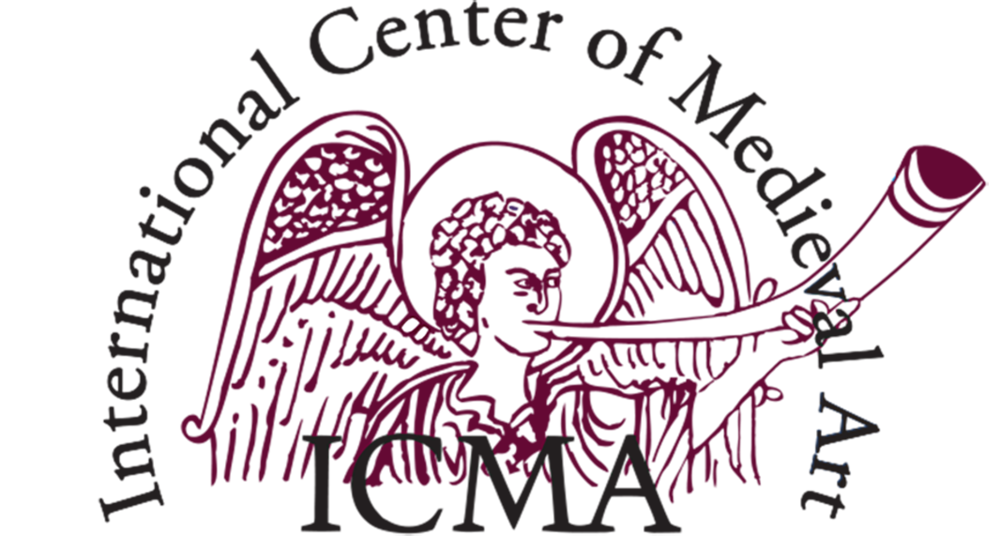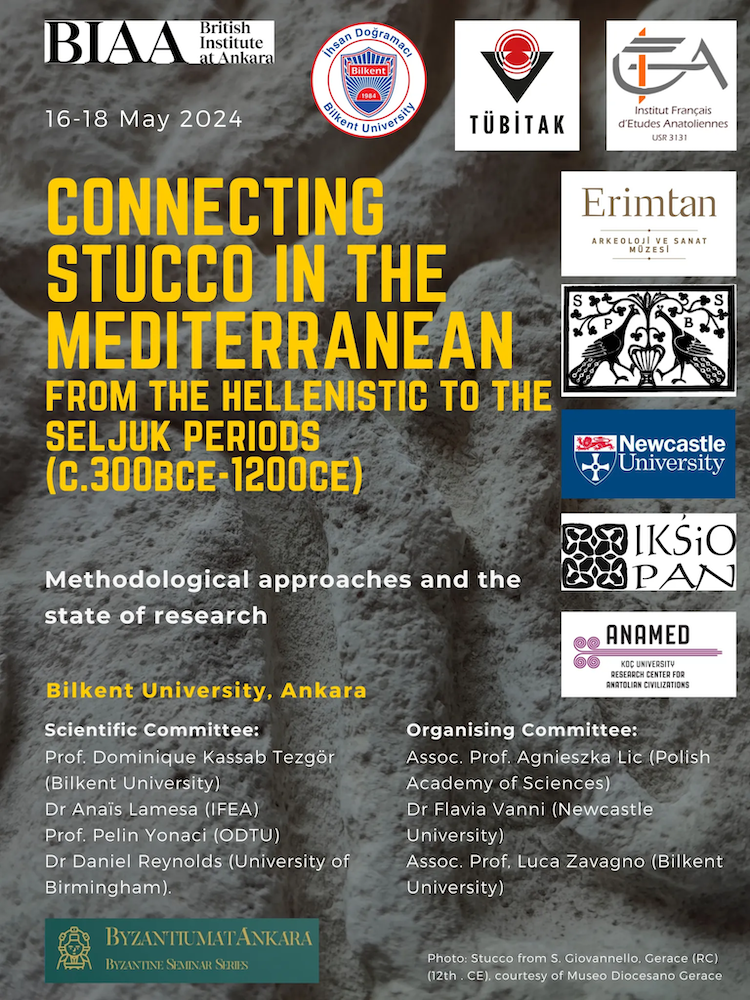CONFERENCE
CONNECTING STUCCO IN THE MEDITERRANEAN (C. 300 BCE- C. 1200 CE)
METHODOLOGICAL APPROACHES AND THE STATE OF RESEARCH
BILKENT UNIVERSITY, ÜNIVERSITELER, 06800 ÇANKAYA/ANKARA, TÜRKIYE
16-18 MAY 2024
The use of plaster reliefs (stuccoes) as architectural decoration is a well-known phenomenon in the Mediterranean, with roots already in ancient Egyptian architecture. However, it has been mainly studied within the boundaries of specific disciplines and chronological specialisations. While this allowed scholars to recognise the relationship of stucco with specific architectural traditions and technologies, it did not allow to spot long-term trends and cross-cultural interactions. This is due to the lack of coordination of scholarship on the study of stucco, which appears to develop at different speeds and aim at different goals depending on the field of study. For example, in the field of Islamic art and archaeology, stucco has mainly been studied in terms of stylistic and iconographic aspects in order to spot cultural exchanges within the Islamicate world; the technological aspect has only recently started to be addressed with archaeometric analyses. At the same time, research on Western Medieval stuccoes benefitted from a more holistic approach, which started to answer the changes in iconography, style, and technologies from the Late Antique to the Early Medieval period. However, the last comprehensive publications on the subject date to the early 2000s and little has been done since then, especially on the archaeometric analyses and their interpretation. The study of stucco makers, their legal and social status have been analysed for Roman stucco and partially for the Western Medieval world, while it is largely missing for the other fields of study on stucco in the period of interest here. The knowledge of Byzantine stucco is still in its infancy, lacking archaeometric analysis and not going beyond the single case studies, except for a limited number of studies.
Despite this dispersed character of research on stucco, many important studies on this material have been produced in the recent decades and the academic community has had multiple occasions to discuss stucco at various conferences and workshops. Therefore, we feel it is time to connect these efforts and address common questions that can help to see long-term phenomena and cross-cultural exchanges in the Mediterranean.
For more information, https://connectingstucco.com/
To register, https://connectingstucco.com/2023/10/15/registration-form/
For any questions please contact: connectingstucco@gmail.com
Publication of the conference proceedings is planned.
CONFERENCE PROGRAMME
Thursday, 16th May – Bilkent University Campus C-Amphi Block
8:30-9:00 Registration and tea/coffee.
9:00-9:10 Opening remarks by Dominique Kassab Tezgör (Chair, Department of Archaeology) and Simon Wigley (Dean, Faculty of Humanities)
9:10-10:00 Opening lecture The “Byzantine” Mediterranean in transition from Late Antiquity to the Early Middle Ages (ca. 500-ca.900).
Luca Zavagno (Bilkent University).
10:00-10:20 Tea and coffee break.
10:20-11:20 Keynote lecture Looking Forwards, Looking Back: The state of the field of Medieval Stucco Studies in the Wider Mediterranean region
Richard McClary (University of York).
11:30-12:30 Session 1: Use and perception of stucco from the Roman to the Late Antique period
Chair: Dominique Kassab Tezgör (Bilkent University)
Stuccowork in the Herodian Palaces – A Roman influence in first-century BCE Middle East?
Lena Naama Sharabi (Hebrew University, Jerusalem).
Decorated stucco moulded cornices and faux-marble columns from Dura Europos (3rd cent. CE): ideological choice or practical necessity?
Barbara Crostini (Uppsala University).
12:30-13:30 Lunch
13:30-15:00 Session 2: Stucco in the Late Antique built spaces
Chair: Roland Smith (Bilkent University)
When Change is a Relief: Stucco surfaces and aesthetic values in Late Antiquity.
Jessica Plant (University of Cambridge).
On a group of standing saints in stucco or the perception of “γυψοπλασίας“ in Late Antiquity.
Stefanie Archut (Rheinische Friedrich-Wilhelms-Universität Bonn).
The virtual reconstruction of the Umayyad period revetments from Khirbat al Mafjar.
Ignacio Arce (German Jordanian University).
15:00-15:15 Tea and coffee break.
15:15-16:45 Session 3: Technical aspects in the Early Middle Ages: East and West
Chair: tbc
Stucco techniques in Lombard and Carolingian Architecture: insights from the “Tempietto Longobardo” in Cividale, the Church of St. Benedict in Mals, and the Monastery of St. John in Müstair.
Luca Villa and Patrick Cassitti (Stiftung Pro Kloster St. Johann).
Early Islamic Prefabricated Stuccowork.
Andrea Luigi Corsi (University of York).
Byzantine stucco recipes in the Mediterranean context (10th -11th c.)- first data from archaeometrical analyses.
Flavia Vanni, Eirini Tsardaka and Georgios Karagiannis (Newcastle University – Ormylia Art & Diagnosys Center).
16:45-17:00 Break
17:00-17:40 Session 4: New technologies for researching architectural decorations
Abstract modelling and virtual photography as architectural method for visualising uncertain archaeological knowledge.
Dominik Lengyel (Brandenburgische Technische Universität Cottbus – Senftenberg)
Q&A for the poster: STUCCO: Stuccoes from the Roman Necropolises of Pozzuoli (1st-3rd century CE, Campania, Italy)- Marie Skłodowska-Curie Actions.
Dorothée Neyme (Université Paris Nanterre – CNR)
20:00 Speakers’ Dinner.
Friday, 17th May – Erimtan Museum, Ankara
9:00-9:10 Welcome speech by Nazan Gezer (Director of the Erimtan Museum)
9:15-10:15 Session 5: Between the Sassanian and Islamic stucco production (1)
Chair: Lutgarde Vandeput (Director of BIAA)
Stucco productions from Gawr Tepe (KRI, Iraq). Preliminary results of a MiSAK-eartHeritage multidisciplinary and comparative study.
Luca Colliva and Serenella Mancini (MiSAK – Alma Mater Studiorum-Università di Bologna).
The production process of traditional Gypsum in Iranian architecture. Case study: Takht-e Soleyman world heritage site.
Mozaffar Abbaszadeh and Mohammad Jafarpanah (Urmia University – Shahid Beheshti University, Tehran).
10:15-10:30 Tea and coffee break.
10:30-12:00 Session 6: Between the Sassanian and Islamic stucco production (2)
Chair: tbc.
The Ghassanid and Umayyad stucco revetments from Qasr al Hallabat.
Ignacio Arce (German Jordanian University).
East versus West: the origins of the Umayyad style in the art of stucco.
Siyana Georgieva (UniToscana).
Beyond borders: exploring the dispersed stucco treasures of Kharg Island.
Hassan Moradi (National Museum of Iran, Teheran).
12:10-13:40 Session 7: Methodological aspects
Chair: Pelin Yoncanci (METU)
Exploring the aesthetic harmony: Islamic stucco patterns and calligraphy in Architectural Design.
Engy Farrag (Delta University).
Methodological approach to characterize two stucco collections from Iran in the Metropolitan Museum of Art.
Atefeh Shekofteh and Federico Caro (The Metropolitan Museum of Art, New York).
Some remarks and recommendations for examination of Mediterranean stuccoes based on research of Medieval Persian carved stuccos, tiles and wall paintings.
Ana Marija Grbanovic (Otto-Friedrich-Universität Bamberg).
13:40-14:30 Lunch.
14:30-15:30 Session 8: People, materials, and images on the move from the Persian Gulf to Egypt (1)
Chair: Alessandro Carabia (University of Birmingham)
Stucco workshops in the Early Islamic Bilad al-Sham and the Arabian/Persian Gulf. The problem of artistic patronage.
Agnieszka Lic (Polish Academy of Sciences).
Tracing decorative dialogues: cultural exchange and artistic assimilation in stucco and brickwork between the Iranian world and Armenian region in 11th-13th centuries.
Miriam Leonetti (Università di Firenze).
15:30-15:45 Tea and coffee break.
15:45-16:45 Session 9: People, materials, and images on the move from the Persian Gulf to Egypt (2)
Chair: Richard McClary (University of York).
The long-distance mobility of Iranian stucco craftsmanship in Cairo.
Leila Danesh (University of York).
How Mamluk stucco decorations inspired Revival architects during the 19th -20th Century AD?
Menna Naguib (Alexandria University).
Saturday 18th May – Bilkent University Campus C-Amphi Block
9:00-9:30 Roundtables.
9:35-10:10 Plenary discussion.
10:15-10:30 Closure remarks by Luca Zavagno, Flavia Vanni and Agnieszka Lic.
Afternoon: Visit to Ankara’s Castle and goodbyes.

